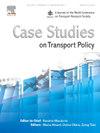Revisiting transport policy through idling exhaust measurements from two-wheelers - A case study
IF 3.3
Q3 TRANSPORTATION
引用次数: 0
Abstract
The automobile sector in India contributes significantly to the ambient air pollution, with two-wheelers (2-Ws) dominating the urban vehicular fleet. The existing phase-out policy for 2-Ws is only based on its age, regardless of other vehicle-specific parameters (VSPs). It is imperative to ascertain key VSPs affecting 2-Ws emissions from the perspective of strengthening such policy. Through real-time exhaust emission testing of 575 2-Ws, the present study finds that VSPs such as mileage, age, and complying emissions standards have a very strong influence on the tailpipe CO and HC (carbon monoxide and hydrocarbon). 2-Ws age and mileage were both significantly correlated with CO and HC (For age, R2 = 0.85 and 0.82, respectively, and for mileage, R2 = 0.84 and 0.81 respectively). Further, the fuel ignition system played a significant role in CO and HC emissions as it was discovered that more recent and sophisticated versions of 2-W engines had lower maximum emissions values when compared to older versions.. Also, kerb weight has a weak correlation to HC and CO emissions (R2 < 0.3), implying that approximately 30 percent of vehicles with the same kerb weight had the similar CO and HC emissions. At present, the 2-W scrapping policy is solely based on its age of fifteen years regardless of any other variables. The study recommends that the relevant environmental and scrappage policy for 2-Ws be suitably upgraded to include mileage as a key factor. It is need of the hour in achieving the desired results towards safer and sustainable transportation.
通过两轮车怠速排放测量重新审视交通政策——一个案例研究
印度的汽车行业对环境空气污染做出了重大贡献,两轮车(2- w)在城市车辆中占主导地位。现有的2- w淘汰政策仅基于车龄,而不考虑其他车辆特定参数(VSPs)。必须从加强此类政策的角度确定影响2- w排放的关键vsp。本研究通过对575 2-Ws的实时尾气排放测试发现,里程、车龄、是否符合排放标准等vsp对尾气CO和HC(一氧化碳和碳氢化合物)的影响非常大。2-Ws年龄、行驶里程与CO、HC均显著相关(年龄R2 = 0.85、0.82,行驶里程R2 = 0.84、0.81)。此外,燃料点火系统在CO和HC排放中发挥了重要作用,因为人们发现,与旧版本相比,最新和复杂版本的2-W发动机具有更低的最大排放值。此外,路肩重与HC和CO排放的相关性较弱(R2 < 0.3),这意味着具有相同路肩重的车辆中约有30%具有相似的CO和HC排放。目前,2-W的报废政策完全基于15年的车龄,而不考虑其他任何变量。该研究建议,相关的环保和报废政策应适当升级,将里程作为一个关键因素。实现更安全和可持续的交通运输的预期结果是迫切需要的。
本文章由计算机程序翻译,如有差异,请以英文原文为准。
求助全文
约1分钟内获得全文
求助全文

 求助内容:
求助内容: 应助结果提醒方式:
应助结果提醒方式:


